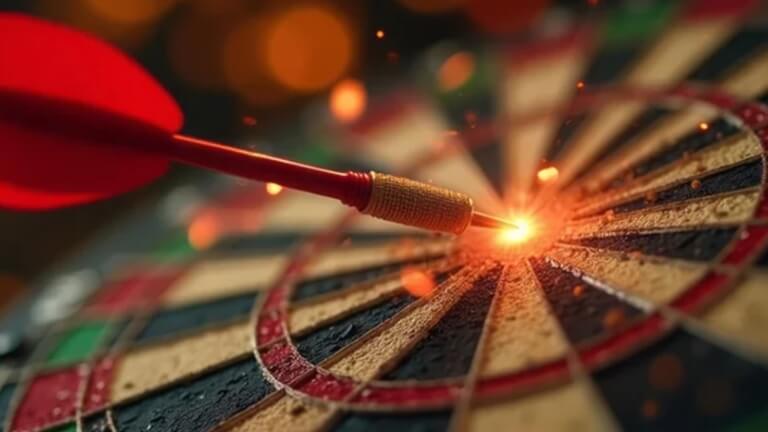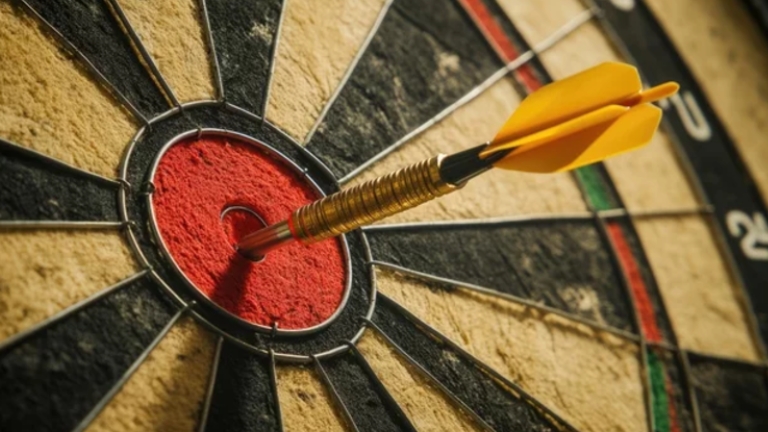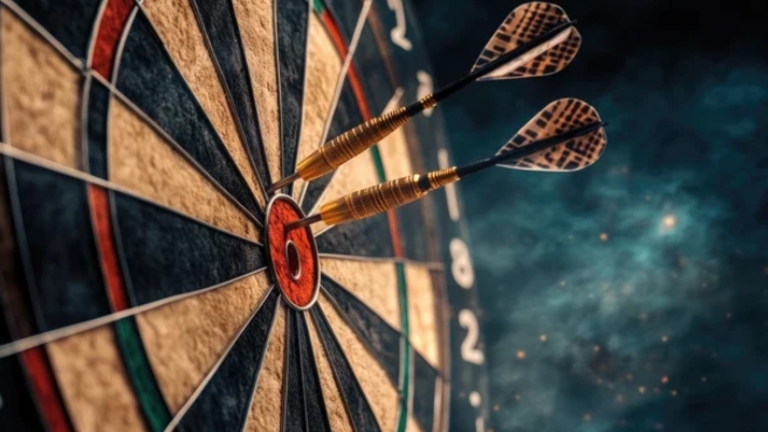Whether you are playing in a friendly match or in a professional tournament, learning the basic rules of darts is the secret to enjoying the game the right way.
The beauty of darts lies in its simplicity, but behind the simplicity is a set of rules that makes the game fair and keeps every match thrilling. The rules set a structure for every great match—from knowing how to score points to knowing different game formats.
So, today we will look through the basic rules that govern darts. So that, one is complete from beginner to professional can get a good idea.
Setting Up for a Game of Darts
You will need the following items in order to play darts:
- A dartboard
- A set of darts (typically three per player)
- A suitable space with enough room to throw safely
Dartboard Setup
Mount the dartboard so the center (bullseye) is 5 feet 8 inches (1.73 meters) from the floor. This ensures a standard height for fair play.
Marking the Throw Line (Oche)
The centers of the throw line, or oche, shall measure not less than 7ft. 9¼ in. (2.37m) from the face of the dartboard. Use tape or a marker to define this clearly.
Choosing the Right Darts
Darts are made in numerous types of material and in a range of sizes. Sometimes beginners use soft darts for tossing, but this depends on the grip and style of throwing.
The Basic Rules of Darts or Scoring in Darts
Darts is a game that any player can pick up and play in a few minutes, but to become a professional player takes sometimes a lifetime. The great thing! All you need to get a few clues about how it is played and rules. Let me break it down for you!
To begin with, the targets are basically divided into 20 serially numbered areas, with every single slice bearing a different point. The “bullseye” in the middle? Getting that is the best worth the most, especially the red center; you get 50, and for the outer green circle, you get 25. The thin inner ring? That is the “triple” zone, and the thin ring outside of it is the “double.” They’ve got a scoring pin that if you make the triple 20, then, boom, you just scored 60 in one turn!
Now, most people play 501. Every player is given 501-point, and each player knocks off their score with each round. The goal is to get to exactly zero, but here’s the kicker: it truly ends only on a double. If you plan on sticking it out when you are at 32 points, then just go for that double 16.
So, scoring is crucial in darts, as players need to manage their points strategically to outplay their opponents and hit the necessary sections at the right time.

The darts game is played with three darts thrown each turn, whereby the players take turns until the last man standing wins. Seems simple, right? However, there are other games such as 301, cricket games, or even practice games, and the same thing holds: precision is key, and so is strategy.
Standard throw distance is 75¾ inches behind the board, and the bull’s-eye should be 68 inches above the ground. And yes, foot placement is important—stand behind the throw line!
Most importantly that darts is a game that is supposed to be entertaining, whether you’re a pub darter, a league player, or just plinking at your house. So get your darts, look for a partner, and you get to aim at those doubles and triples. Happy throwing!
Different Types of Darts Games and Darts Rules
There are a lot of variations in darts games available in the world. Peoples are playing in different ways in different countries. Here’s a look at some popular dart games you can play, whether at home, in a bar, or during a league night.
501 and 301 Darts
The game begins, and the goal is clear: bring that starting score—501 or 301—down to exactly zero. With each dart thrown, there’s a mix of strategy, focus, and a bit of luck.
You start by aiming for the big scores: the triple 20 is your best friend, racking up a neat 60 points with a single dart. But let’s be real—hitting it consistently isn’t as easy as it looks. Miss slightly, and you’re in the single 20 or, worse, the 5 or 1.
In 501, you’ve got more room to maneuver, building a rhythm before worrying about the dreaded “double out” rule. In 301, its crunch time from the start. Most games require you to hit a double to “open” and start scoring—pressure builds as you try to find that perfect double ring. Once you’re in, it’s a race to zero.
The beauty of both games is the finish. With a few points left, you’ll need precision. You calculate: 32 left? That’s a double 16. You throw; hold your breath, and bam! It hits! Victory feels electric.
Whether it’s 501’s marathon or 301’s sprint, each game is a test of skill, nerve, and that undeniable joy of hitting the perfect shot.
Around the World Darts
To the game starts, the aim is simple: hit every number on the board, one by one, starting at 1 and finishing on 20. Sounds easy, right? Not quite.
You start aiming at the 1, working into the rhythm. First dart lands outside it, but on the second attempt-got it! Now onto the 2. The pressure rises as each number requires focus. The catch? You can’t skip numbers. If you’re stuck on 7, you stay stuck until you hit it. That’s the fun of Around the World.
By 10, you were feeling confident, triple sections, tempting for speed, but a clean hit anywhere on the number counts. By 13 or 14, the fatigue starts to creep in. The higher you go, closer to 20, the stakes rise. Each throw feels deliberate—especially when you are racing against a friend.

And then there comes the final shot: 20. All eyes are on the board. You steady my hand, breathe, and let the dart fly. It’s in! A wave of relief and triumph sweeps over you.
Around the World isn’t just a game; it’s a test of precision and endurance. Every number tells a story, and every victory feels earned
The Cricket Darts
The strategic elements in playing Cricket darts involve a great degree of precision. In theory, this can be quite simple, but in actual practice, it takes time.
First, there is the need to understand the rules of the game: you aim to close out numbers 20, 19, 18, 17, 16, 15, and the bullseye by hitting them three times each. A single hit counts as one, a double counts as two, and a triple counts as three. Your goal is to close these numbers before your opponent, while at the same time gathering points.
You step up to the oche, focused. The game begins with the 20s. You need three hits to close it, so you’re going for the triple 20 right off the bat. First dart? Single. Not ideal, but I’ve got time. The second dart goes for the triple-and yes, it sticks. That’s two hits. One more and you have done with 20s.
Now, you have to keep track of my opponent, who’s probably closing their own numbers while you do mine. The key is timing-do you close a number quickly or try to rack up points while your opponent’s still working on theirs?
It’s a balance of offense and defense as the game goes on, choosing when to score and when to close. And the thrill is that they close everything out before they do. That’s the sweet spot in Cricket darts. That’s the sweet spot in Cricket darts.
The Killer Darts
Killer Darts is a fun, aggressive game that’s great for any group. Here’s how you get started:
At first, each player is assigned a number. You can draw randomly for these or do it according to who wants to go first. Simple concept to eliminate the other players while protecting your own number.
The game starts by having each player throw their darts at the dartboard. The aim of it is to hit the other players’ numbers and “kill” them off. You do this by hitting their number three times. When you hit a shot on their number, mark it down; once you hit it three times, that player is out.
But here’s the catch: You’re also trying to avoid being hit! You don’t want anyone hitting your number. If a player hits your number three times, you’re out, and you’re left watching from the sidelines.
The twist is that after a player has killed everyone else but one, he becomes the “Killer.” In a one-on-one situation, the last man standing needs to confront the Killer and defeat him to win the game. The Killer can only be defeated if you hit his number three times, but if you’re the one landing those three hits, then you win.
Killer Darts is all about strategy; aiming at your opponent’s number, while keeping a sharp eye on yours, and just enjoying time spent with friends.
Tic Tac Toe Darts
Tic Tac Toe Darts is a fun twist in the classic game, and it’s perfect for casual play in the dart session with friends. Here’s how you play:
First, take a dartboard and set it up to the regular specs. The main variation is that instead of taking the normal zones for scoring on the dartboard, you will be dividing it into a 3×3 grid on the dartboard like a normal tic-tac-toe board. You can mark this grid with chalk or stickers, or you can simply divide the board mentally into nine squares.
Each player chooses an X or O as his or her signature mark. The objective of the game, much like the traditional Tic Tac Toe, is to achieve three continuous marks of your signature horizontally, vertically, or diagonally.
You throw one dart at the board on your turn. If it lands on a number, that number corresponds to a square in the grid. For example, if you hit a 10, it might represent the top row, middle column of your tic-tac-toe grid. Once you hit a spot, mark it with your symbol—X or O.
You keep taking turns, trying to block your opponent from getting three in a row, while you yourself are trying to complete your own line, but here is the catch—you can’t hit the same square twice. If someone already has it, then it’s blocked!
The first person to get three marks in a row wins. It is a balance of ability, strategy, and a little bit of luck, which makes the game of Tic Tac Toe darts appeal to anyone!
Darts Rules for the World Cup
There are also a couple of small differences in the rules of the World Darts Championship in comparison with the standard one. In a singles competition such as the World Championship darts-related match, one contestant must defeat another by taking a specific number of sets.
The first two rounds have a winner who, to progress to the next round, has to win three sets. In the World Darts Championship match, the player who scores the three legs in a set wins it the first time he does so.

In the World Darts Championship, a player might theoretically win more legs than his opponent and still be declared a loser and disqualified from the competition.
Straight Out in Darts Game
When a darts player says “Straight Out,” the player has just done a direct checkout, which mostly starts from a big score such as 170. It is a clean, perfect move where a player captures the required points in the specific order needed to win the game. For example, in a standard 501 match, attaining a score of triple 20, triple 20, and double 15 is known as a ‘Straight Out’.
It is a trick and is cool, and I love it because it requires skill and precision. No more darts, no more blunders—just the final shot. This is the type of moment that can make a match a classic and leave everyone, including the players, so it’s surprised.
The Double In and The Double Out
In darts, “Double In” and “Double Out” are important parts of games like 501. A “Double In” means a player has to hit a double to start scoring. For example, they might need to hit double 20 to begin the game. This adds a challenge from the very start.
On the other hand, “Double Out” is about how a player ends the game. To win, a player must hit a double that matches the exact remaining score. For example, if a player has 40 points left, they must hit double 20 to win. These rules make the game more strategic, needing not only skill but also careful planning and accuracy to achieve the right finish.
The Rules of Team Darts
Team darts is a way for players to compete in groups, usually in pairs or larger teams, against other groups. It focuses on teamwork, planning, and talking to each other, as players depend on each other’s skills to win.
Usually, team events include a mix of individual, pair, and sometimes mixed games, where each team member helps to get the total score.
Team darts is enjoyed in both casual and professional places, and it helps build friendship and a feeling of shared success. Famous competitions like the World Cup of Darts show the exciting parts of team play, emphasizing the value of team strategy and personal skill.
Tips for beginners to improve the rules in darts
If you think you need to improve your skills as a beginner player then you must follow the below tips.
- Know the basic rules for scoring in 501 and 301 games, like taking points from your opponents and finishing the round with a double.
- It’s good to learn about the sections, doubles, triples, and the bullseye to improve your chances of winning.
- Keep a good stance, grip, and follow-through to stay steady and accurate.
- Learn common violations or foul rules, like stepping over the oche (throwing line), to avoid penalties.
- Knowing common double-out finishes can help you score quickly.
- Respect opponents by staying quiet during their turn and retrieving darts only after scoring. Play open matches to get used to the game and build confidence.
Darts Etiquette and Sportsmanship
In every game, players have to follow certain etiquette to respect the game. If a player follows the etiquette, then that player will respect his game, and similarly, his fans will respect him at the professional level. So let’s follow the below details.

- Never run across the throwing line when other players are through with their throwing. Should not lean on it or step over it in a match since this may cause a distraction or go against certain rules.
- Do not speak, shout, or make other loud noises when someone is throwing to distract them.
- You should only pick your darts off the board after all the players in the round have tossed theirs. It is dangerous to try to walk toward the board before the depth of the water is determined.
- Before the match, shake hands or perform a fist bump gesture with the opponent, and after the match, no matter who won, applaud or even thank the opponent.
- The last thing you want to do is allow your team to get carried away primarily in a closely contested match and lose respect for the opponent.
- Let the person who is monitoring the score follow his or her work closely without so much interjection or irrelevant remark.
- Any concerns that may arise about scores or rules should be handled in a polite and gentle manner between teams.
- Leave your winning attitude and never sulk when you lose, allowing for orderliness.
- Follow the standard rules of the house to protect forgery and fairness of the playing field for all sporting events.
- Always be honest in your gameplay and uphold the spirit of darts, supporting others when they excel.
What is the Highest Darts Score?
In darts, the highest score you can get in one turn is 180. This happens when you hit three triple-20s, because the triple ring on the 20 section gives you 60 points per dart. This score is called a “maximum,” and getting 180 is seen as the best example of accuracy and skill in the game.
Even though it doesn’t end the game, players try to get 180 to use fewer darts to reach the target score, usually 501 in professional games. When someone scores 180, the audience and commentators get really excited, making it one of the most exciting moments in a darts match.
How do you Win Darts Rules?
To win a game of darts, players need to bring their starting score (usually 501) down to exactly zero, finishing on a double or the bullseye. Players take turns throwing three darts each, trying to score points by hitting numbered areas on the dartboard. The points from each turn are subtracted from their remaining score.
When a player is close to zero, they must carefully “finish” by hitting the exact number needed with their last dart landing in a double. If a player scores too many points or doesn’t hit a double, their turn ends without reducing their score, and the game continues.
How long is a Game of Darts?
The length of a darts game varies depending on the format, skill level, and pace of play. For casual games, a single leg (from 501 to zero) can take around 5-10 minutes.In professional matches, a leg is often completed in less than 2-3 minutes, with top players achieving finishes in as few as 9 darts.
Tournament games typically consist of multiple legs and sets, extending the duration to anywhere from 20 minutes to over an hour. Factors like frequent scoring checks, strategic pauses, or slower players can also influence the time. Overall, darts’ duration is highly flexible and game-dependent.
What Country is Darts most Popular In?
Darts is very popular in the United Kingdom, especially in England, where it started and became a common game in pubs. Many people play it, both as a hobby and as a professional sport. There are groups like the Professional Darts Corporation (PDC) that support the professional players.
Big events, like the World Darts Championship, attract lots of fans and get high TV viewership in the UK. Darts is also becoming more popular in other countries like the Netherlands, Germany, Australia, and United State because of famous players and international competitions. But the UK is still the main place for darts, with its long history and wide popularity.

